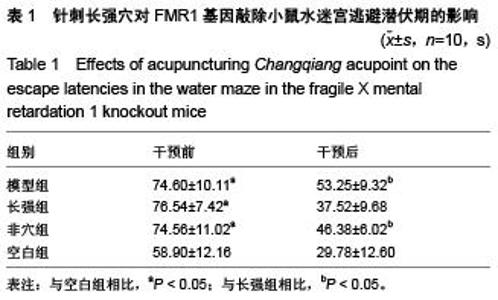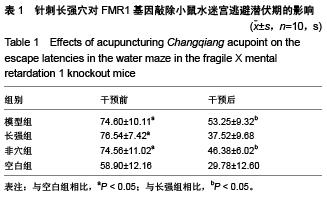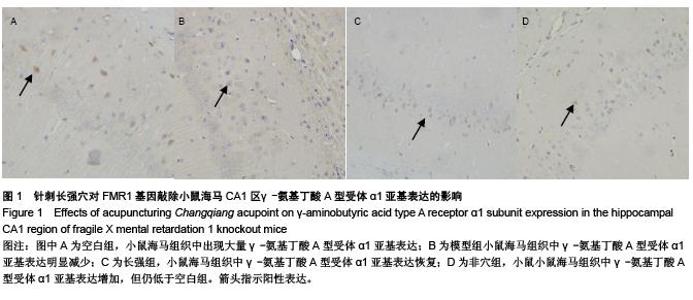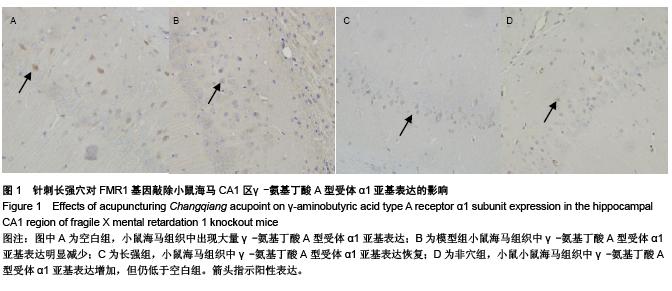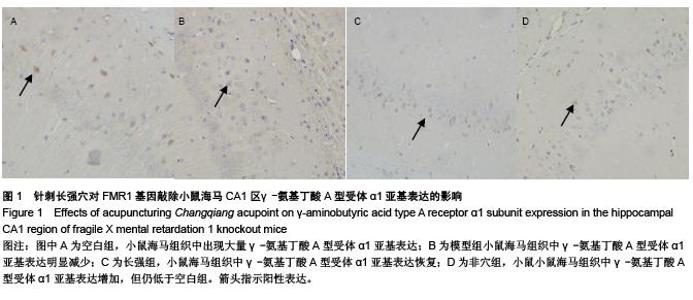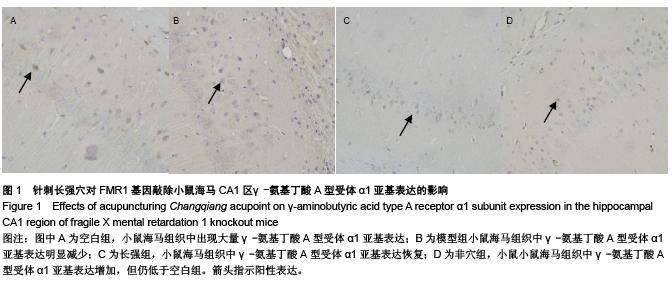Chinese Journal of Tissue Engineering Research ›› 2015, Vol. 19 ›› Issue (49): 7964-7968.doi: 10.3969/j.issn.2095-4344.2015.49.016
Previous Articles Next Articles
Effects of acupuncturing Changqiang acupoint on the learning and memory function and gamma-aminobutyric acid type A receptor alpha1 subunit expression in the hippocampal CA1 region of the fragile X mental retardation 1 located on X chromosome knockout mice
Wu Qiang1, Chen Li-yun2, Zhang Xue-jun1
- 1College of Acupuncture and Massage, Fujian University of Traditional Chinese Medicine, Fuzhou 350122, Fujian Province, China; 2Chinese Medicine Hospital of Fuzhou, Fuzhou 350001, Fujian Province, China
-
Received:2015-09-18Online:2015-11-30Published:2015-11-30 -
About author:Wu Qiang, M.D., Professor, Doctoral supervisor, College of Acupuncture and Massage, Fujian University of Traditional Chinese Medicine, Fuzhou 350122, Fujian Province, China -
Supported by:the National Natural Science Foundation of China, No. 81373720; the Key Project of Social Development Division of Fujian Provincial Science and Technology Department, No. 2012Y0045
CLC Number:
Cite this article
Wu Qiang, Chen Li-yun, Zhang Xue-jun. Effects of acupuncturing Changqiang acupoint on the learning and memory function and gamma-aminobutyric acid type A receptor alpha1 subunit expression in the hippocampal CA1 region of the fragile X mental retardation 1 located on X chromosome knockout mice [J]. Chinese Journal of Tissue Engineering Research, 2015, 19(49): 7964-7968.
share this article
| [1] Levenga J, de Vrij FM, Oostra BA, et al. Potential therapeutic interventions for fragile X syndrome. Trends Mol Med. 2010; 16(11):516-527. [2] Pieretti M, Zhang FP, Fu YH, et al. Absence of expression of the FMR-1 gene in fragile X syndrome. Cell. 1991;66(4): 817-822. [3] Iliff AJ, Renoux AJ, Krans A, et al. Impaired activity-dependent FMRP translation and enhanced mGluR-dependent LTD in Fragile X premutation mice. Hum Mol Genet. 2013;22(6): 1180-1192. [4] Kimura I, Nakayama Y, Zhao Y, et al. Neurotrophic effects of neudesin in the central nervous system. Front Neurosci. 2013;7:111. [5] Budnik V, Salinas PC. Wnt signaling during synaptic development and plasticity. Curr Opin Neurobiol. 2011;21(1): 151-159. [6] 朱丽娜,王春枝.脆性X综合征发病机制与治疗研究进展[J].中国优生与遗传杂志,2010,18(12):3-4. [7] 吴强,韩平,王振宇,等.针刺长强穴治疗精神发育迟滞患儿57例多中心临床研究报告[J].中华中医药杂志,2011,26(11):2668-2671. [8] 韩平,王振宇,林栋,等.浅谈针刺长强穴改善儿童智力残疾[J].中华中医药杂志,2011,26(5):1239-1240. [9] 韩平,俞萍,陈可爱,等.针刺长强穴对FMR1基因敲除小鼠海马CA1区BDNF和SYN表达的影响[J].福建中医药大学学报,2012, 22(5):14-18. [10] 许静,尹晓慧,张光毅.GABAA受体激活BDNF-TrkB-ERK信号通路在脑缺血中的作用[J].徐州医学院学报,2011,31(7):441-444. [11] D'Hulst C, Kooy RF. The GABAA receptor: a novel target for treatment of fragile X? Trends Neurosci. 2007;30(8):425-431. [12] 周丽,张允岭,孟繁兴.针灸治疗血管性轻度认知障碍研究思路[J].山东中医药大学学报,2012,36(1):29-30. [13] 王金桥,王金玲.轻度认知障碍与肺及督脉的关系[J].山东中医药大学学报,2012,33(1):113. [14] 刘立公,顾杰,刘婕,等.古代文献中督脉及其腧穴主治的统计报告[J].针灸临床杂志,2010,26(5):43-45. [15] Paxinos G, Watson C. The Rat Brain in Stereotaxic Coordinates. 5th ed. London: Academic Press,2005. [16] 宋妍.针刺长强穴改善小儿生物因素智力低下的优势[D].福州:福建中医学院,2009. [17] 赵三军,朱亚静,米卫东.γ-氨基丁酸受体和神经发生[J].国际麻醉学与复苏杂志,2012,33(7):474-476. [18] 杜静.神经营养因子和细胞因子在介导针灸效应中的作用[J].针刺研究,2008,33(1):37-40. [19] 孙卫文,黄越玲,张维雯,等.三十日龄FMR1基因敲除小鼠的水迷宫实验观察[J].解剖学研究,2011,33(1):13-16. [20] 徐琴,竺智伟,赵正言.脆性X综合征树突棘形态发育研究进展[J].神经解剖学杂志, 2009,23(5):387-389. |
| [1] | Chen Ziyang, Pu Rui, Deng Shuang, Yuan Lingyan. Regulatory effect of exosomes on exercise-mediated insulin resistance diseases [J]. Chinese Journal of Tissue Engineering Research, 2021, 25(25): 4089-4094. |
| [2] | Chen Yang, Huang Denggao, Gao Yuanhui, Wang Shunlan, Cao Hui, Zheng Linlin, He Haowei, Luo Siqin, Xiao Jingchuan, Zhang Yingai, Zhang Shufang. Low-intensity pulsed ultrasound promotes the proliferation and adhesion of human adipose-derived mesenchymal stem cells [J]. Chinese Journal of Tissue Engineering Research, 2021, 25(25): 3949-3955. |
| [3] | Yang Junhui, Luo Jinli, Yuan Xiaoping. Effects of human growth hormone on proliferation and osteogenic differentiation of human periodontal ligament stem cells [J]. Chinese Journal of Tissue Engineering Research, 2021, 25(25): 3956-3961. |
| [4] | Sun Jianwei, Yang Xinming, Zhang Ying. Effect of montelukast combined with bone marrow mesenchymal stem cell transplantation on spinal cord injury in rat models [J]. Chinese Journal of Tissue Engineering Research, 2021, 25(25): 3962-3969. |
| [5] | Gao Shan, Huang Dongjing, Hong Haiman, Jia Jingqiao, Meng Fei. Comparison on the curative effect of human placenta-derived mesenchymal stem cells and induced islet-like cells in gestational diabetes mellitus rats [J]. Chinese Journal of Tissue Engineering Research, 2021, 25(25): 3981-3987. |
| [6] | Hao Xiaona, Zhang Yingjie, Li Yuyun, Xu Tao. Bone marrow mesenchymal stem cells overexpressing prolyl oligopeptidase on the repair of liver fibrosis in rat models [J]. Chinese Journal of Tissue Engineering Research, 2021, 25(25): 3988-3993. |
| [7] | Liu Jianyou, Jia Zhongwei, Niu Jiawei, Cao Xinjie, Zhang Dong, Wei Jie. A new method for measuring the anteversion angle of the femoral neck by constructing the three-dimensional digital model of the femur [J]. Chinese Journal of Tissue Engineering Research, 2021, 25(24): 3779-3783. |
| [8] | Meng Lingjie, Qian Hui, Sheng Xiaolei, Lu Jianfeng, Huang Jianping, Qi Liangang, Liu Zongbao. Application of three-dimensional printing technology combined with bone cement in minimally invasive treatment of the collapsed Sanders III type of calcaneal fractures [J]. Chinese Journal of Tissue Engineering Research, 2021, 25(24): 3784-3789. |
| [9] | Qian Xuankun, Huang Hefei, Wu Chengcong, Liu Keting, Ou Hua, Zhang Jinpeng, Ren Jing, Wan Jianshan. Computer-assisted navigation combined with minimally invasive transforaminal lumbar interbody fusion for lumbar spondylolisthesis [J]. Chinese Journal of Tissue Engineering Research, 2021, 25(24): 3790-3795. |
| [10] | Hu Jing, Xiang Yang, Ye Chuan, Han Ziji. Three-dimensional printing assisted screw placement and freehand pedicle screw fixation in the treatment of thoracolumbar fractures: 1-year follow-up [J]. Chinese Journal of Tissue Engineering Research, 2021, 25(24): 3804-3809. |
| [11] | Shu Qihang, Liao Yijia, Xue Jingbo, Yan Yiguo, Wang Cheng. Three-dimensional finite element analysis of a new three-dimensional printed porous fusion cage for cervical vertebra [J]. Chinese Journal of Tissue Engineering Research, 2021, 25(24): 3810-3815. |
| [12] | Wang Yihan, Li Yang, Zhang Ling, Zhang Rui, Xu Ruida, Han Xiaofeng, Cheng Guangqi, Wang Weil. Application of three-dimensional visualization technology for digital orthopedics in the reduction and fixation of intertrochanteric fracture [J]. Chinese Journal of Tissue Engineering Research, 2021, 25(24): 3816-3820. |
| [13] | Sun Maji, Wang Qiuan, Zhang Xingchen, Guo Chong, Yuan Feng, Guo Kaijin. Development and biomechanical analysis of a new anterior cervical pedicle screw fixation system [J]. Chinese Journal of Tissue Engineering Research, 2021, 25(24): 3821-3825. |
| [14] | Lin Wang, Wang Yingying, Guo Weizhong, Yuan Cuihua, Xu Shenggui, Zhang Shenshen, Lin Chengshou. Adopting expanded lateral approach to enhance the mechanical stability and knee function for treating posterolateral column fracture of tibial plateau [J]. Chinese Journal of Tissue Engineering Research, 2021, 25(24): 3826-3827. |
| [15] | Zhu Yun, Chen Yu, Qiu Hao, Liu Dun, Jin Guorong, Chen Shimou, Weng Zheng. Finite element analysis for treatment of osteoporotic femoral fracture with far cortical locking screw [J]. Chinese Journal of Tissue Engineering Research, 2021, 25(24): 3832-3837. |
| Viewed | ||||||
|
Full text |
|
|||||
|
Abstract |
|
|||||
